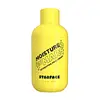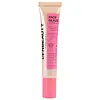What's inside
What's inside
 Key Ingredients
Key Ingredients

 Benefits
Benefits

 Concerns
Concerns

 Ingredients Side-by-side
Ingredients Side-by-side

Water
Skin ConditioningIsononyl Isononanoate
EmollientCaprylic/Capric Triglyceride
MaskingCetearyl Olivate
C14-22 Alcohols
Emulsion StabilisingSorbitan Olivate
EmulsifyingEthylhexylglycerin
Skin ConditioningC12-20 Alkyl Glucoside
EmulsifyingSilica
AbrasiveXanthan Gum
EmulsifyingGlycerin
HumectantTocopheryl Acetate
AntioxidantButylene Glycol
HumectantAloe Barbadensis Leaf Extract
EmollientTocopherol
AntioxidantSodium Hyaluronate
HumectantMagnesium Aspartate
Skin ConditioningZinc Gluconate
Skin ConditioningPhenoxyethanol
PreservativeOcimum Sanctum Leaf Extract
Skin ConditioningSalvia Officinalis Leaf Extract
CleansingCopper Gluconate
Skin ConditioningSodium Benzoate
MaskingPotassium Sorbate
PreservativePanax Ginseng Root Extract
EmollientChenopodium Quinoa Seed Extract
Skin ConditioningDaucus Carota Sativa Root Extract
Skin ConditioningGlycine Max Seed Extract
Skin ConditioningOryza Sativa Extract
AbsorbentWater, Isononyl Isononanoate, Caprylic/Capric Triglyceride, Cetearyl Olivate, C14-22 Alcohols, Sorbitan Olivate, Ethylhexylglycerin, C12-20 Alkyl Glucoside, Silica, Xanthan Gum, Glycerin, Tocopheryl Acetate, Butylene Glycol, Aloe Barbadensis Leaf Extract, Tocopherol, Sodium Hyaluronate, Magnesium Aspartate, Zinc Gluconate, Phenoxyethanol, Ocimum Sanctum Leaf Extract, Salvia Officinalis Leaf Extract, Copper Gluconate, Sodium Benzoate, Potassium Sorbate, Panax Ginseng Root Extract, Chenopodium Quinoa Seed Extract, Daucus Carota Sativa Root Extract, Glycine Max Seed Extract, Oryza Sativa Extract
Water
Skin ConditioningGlycerin
HumectantCaprylic/Capric Triglyceride
MaskingSqualane
EmollientGlycereth-26
HumectantDipropylene Glycol
HumectantBetaine
HumectantTriisostearin
Skin ConditioningDipentaerythrityl Hexa C5-9 Acid Esters
Skin Conditioning1,2-Hexanediol
Skin ConditioningCeramide NP
Skin ConditioningCitrullus Lanatus Fruit Extract
Skin ConditioningTerminalia Ferdinandiana Fruit Extract
AntioxidantSodium Hyaluronate
HumectantCurcuma Longa Root Extract
MaskingSilica
AbrasiveBoerhavia Diffusa Root Extract
Skin ProtectingPinus Pinaster Bark Extract
AntioxidantVanilla Planifolia Fruit Extract
Skin ConditioningPropanediol
SolventPhytosphingosine
Skin ConditioningEicosapentaenoic Acid
EmollientSorbitan Oleate
EmulsifyingCaprylyl/Capryl Glucoside
CleansingPhospholipids
Skin ConditioningCetearyl Olivate
Sorbitan Olivate
EmulsifyingXanthan Gum
EmulsifyingCarbomer
Emulsion StabilisingSorbitol
HumectantPhosphatidylcholine
EmulsifyingDocosahexaenoic Acid
Skin ConditioningHydrogenated Polydecene
EmollientCetearyl Alcohol
EmollientSynthetic Fluorphlogopite
Sodium Acrylate/Sodium Acryloyldimethyl Taurate Copolymer
Emulsion StabilisingButylene Glycol
HumectantTetrasodium Glutamate Diacetate
Cholesterol
EmollientC14-22 Alcohols
Emulsion StabilisingPolyisobutene
Tocopheryl Acetate
AntioxidantSodium Stearoyl Glutamate
CleansingAlumina
AbrasiveC12-20 Alkyl Glucoside
EmulsifyingTriethylhexanoin
MaskingMica
Cosmetic ColorantTin Oxide
AbrasiveCI 77891
Cosmetic ColorantCI 77491
Cosmetic ColorantEthylhexylglycerin
Skin ConditioningWater, Glycerin, Caprylic/Capric Triglyceride, Squalane, Glycereth-26, Dipropylene Glycol, Betaine, Triisostearin, Dipentaerythrityl Hexa C5-9 Acid Esters, 1,2-Hexanediol, Ceramide NP, Citrullus Lanatus Fruit Extract, Terminalia Ferdinandiana Fruit Extract, Sodium Hyaluronate, Curcuma Longa Root Extract, Silica, Boerhavia Diffusa Root Extract, Pinus Pinaster Bark Extract, Vanilla Planifolia Fruit Extract, Propanediol, Phytosphingosine, Eicosapentaenoic Acid, Sorbitan Oleate, Caprylyl/Capryl Glucoside, Phospholipids, Cetearyl Olivate, Sorbitan Olivate, Xanthan Gum, Carbomer, Sorbitol, Phosphatidylcholine, Docosahexaenoic Acid, Hydrogenated Polydecene, Cetearyl Alcohol, Synthetic Fluorphlogopite, Sodium Acrylate/Sodium Acryloyldimethyl Taurate Copolymer, Butylene Glycol, Tetrasodium Glutamate Diacetate, Cholesterol, C14-22 Alcohols, Polyisobutene, Tocopheryl Acetate, Sodium Stearoyl Glutamate, Alumina, C12-20 Alkyl Glucoside, Triethylhexanoin, Mica, Tin Oxide, CI 77891, CI 77491, Ethylhexylglycerin
 Reviews
Reviews

Ingredients Explained
These ingredients are found in both products.
Ingredients higher up in an ingredient list are typically present in a larger amount.
Butylene Glycol (or BG) is used within cosmetic products for a few different reasons:
Overall, Butylene Glycol is a safe and well-rounded ingredient that works well with other ingredients.
Though this ingredient works well with most skin types, some people with sensitive skin may experience a reaction such as allergic rashes, closed comedones, or itchiness.
Learn more about Butylene GlycolWe don't have a description for C12-20 Alkyl Glucoside yet.
C14-22 Alcohols is made up of synthetic fatty alcohols. More specifically, these fatty alcohols contain 14 to 22 carbons in the alkyl chain.
Its main purpose is to stabilize products. As an emulsifier, it helps prevent waters and oils from separating.
This ingredient is an emollient, solvent, and texture enhancer. It is considered a skin-softener by helping the skin prevent moisture loss.
It helps thicken a product's formula and makes it easier to spread by dissolving clumping compounds.
Caprylic Triglyceride is made by combining glycerin with coconut oil, forming a clear liquid.
While there is an assumption Caprylic Triglyceride can clog pores due to it being derived from coconut oil, there is no research supporting this.
Learn more about Caprylic/Capric TriglycerideCetearyl Olivate is an emulsifier and texture enhancer. It is derived from the fatty acids of olive oil and Cetearyl alcohol, and is biodegradable.
As an emulsifier, it is used to prevent oils and waters from separating. It can also
Manufacturers use the name Olivem 1000. This ingredient has been found to preserve the natural microbiome of skin. Having a healthy microbiome helps keep our skin healthy and protects against harmful bacteria. This ingredient is grouped with Sorbitan Olivate under the name Olivem 1000.
Learn more about Cetearyl OlivateEthylhexylglycerin (we can't pronounce this either) is commonly used as a preservative and skin softener. It is derived from glyceryl.
You might see Ethylhexylglycerin often paired with other preservatives such as phenoxyethanol. Ethylhexylglycerin has been found to increase the effectiveness of these other preservatives.
Glycerin is already naturally found in your skin. It helps moisturize and protect your skin.
A study from 2016 found glycerin to be more effective as a humectant than AHAs and hyaluronic acid.
As a humectant, it helps the skin stay hydrated by pulling moisture to your skin. The low molecular weight of glycerin allows it to pull moisture into the deeper layers of your skin.
Hydrated skin improves your skin barrier; Your skin barrier helps protect against irritants and bacteria.
Glycerin has also been found to have antimicrobial and antiviral properties. Due to these properties, glycerin is often used in wound and burn treatments.
In cosmetics, glycerin is usually derived from plants such as soybean or palm. However, it can also be sourced from animals, such as tallow or animal fat.
This ingredient is organic, colorless, odorless, and non-toxic.
Glycerin is the name for this ingredient in American English. British English uses Glycerol/Glycerine.
Learn more about GlycerinSilica, also known as silicon dioxide, is a naturally occurring mineral. It is used as a fine, spherical, and porous powder in cosmetics.
Though it has exfoliant properties, the function of silica varies depending on the product.
The unique structure of silica enhances the spreadability and adds smoothness, making it a great texture enhancer.
It is also used as an active carrier, emulsifier, and mattifier due to its ability to absorb excess oil.
In some products, tiny microneedles called spicules are made from silica or hydrolyzed sponge. When you rub them in, they lightly polish away dead skin layers and enhance the penetration of active ingredients.
Learn more about SilicaSodium Hyaluronate is hyaluronic acid's salt form. It is commonly derived from the sodium salt of hyaluronic acid.
Like hyaluronic acid, it is great at holding water and acts as a humectant. This makes it a great skin hydrating ingredient.
Sodium Hyaluronate is naturally occurring in our bodies and is mostly found in eye fluid and joints.
These are some other common types of Hyaluronic Acid:
Learn more about Sodium HyaluronateSorbitan Olivate is created from the fatty acids in olive oil and sorbitol.
This ingredient is an oil in water emulsifier. It helps stabilize a product by preventing oils and waters from separating. Sorbitan Olivate also helps hydrate the skin.
Manufacturers sell sorbitan olivate under the name OliveM 1000. OliveM 1000 a multifunctional ingredient. It is self-emulsifying. According to a manufacturer, OliveM 1000 does not disrupt natural skin biome.
Due to its olive oil base, this ingredient may not be fungal-acne safe.
Learn more about Sorbitan OlivateTocopheryl Acetate is AKA Vitamin E. It is an antioxidant and protects your skin from free radicals. Free radicals damage the skin by breaking down collagen.
One study found using Tocopheryl Acetate with Vitamin C decreased the number of sunburned cells.
Tocopheryl Acetate is commonly found in both skincare and dietary supplements.
Learn more about Tocopheryl AcetateWater. It's the most common cosmetic ingredient of all. You'll usually see it at the top of ingredient lists, meaning that it makes up the largest part of the product.
So why is it so popular? Water most often acts as a solvent - this means that it helps dissolve other ingredients into the formulation.
You'll also recognize water as that liquid we all need to stay alive. If you see this, drink a glass of water. Stay hydrated!
Learn more about WaterXanthan gum is used as a stabilizer and thickener within cosmetic products. It helps give products a sticky, thick feeling - preventing them from being too runny.
On the technical side of things, xanthan gum is a polysaccharide - a combination consisting of multiple sugar molecules bonded together.
Xanthan gum is a pretty common and great ingredient. It is a natural, non-toxic, non-irritating ingredient that is also commonly used in food products.
Learn more about Xanthan Gum